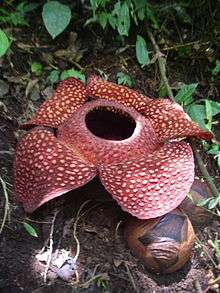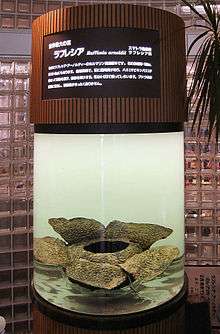Rafflesia arnoldii
| Rafflesia arnoldii | |
|---|---|
 | |
| Rafflesia arnoldii flower and bud | |
| Scientific classification | |
| Kingdom: | Plantae |
| (unranked): | Angiosperms |
| (unranked): | Eudicots |
| (unranked): | Rosids |
| Order: | Malpighiales |
| Family: | Rafflesiaceae |
| Genus: | Rafflesia |
| Species: | R. arnoldii |
| Binomial name | |
| Rafflesia arnoldii R.Br. | |
| Synonyms | |
| |
Rafflesia arnoldii is a member of the genus Rafflesia. It is noted for producing the largest individual flower on earth. It has a very strong and horrible odour of decaying flesh, earning it the nickname "corpse flower". It is endemic to the rainforests of Sumatra and possibly Borneo.[1] Although there are some plants with larger flowering organs like the titan arum (Amorphophallus titanum) and talipot palm (Corypha umbraculifera), those are technically clusters of many flowers.
Rafflesia arnoldii (Indonesian: padma raksasa), also called Kerubut (Devil's Betelnut Box) is one of the three national flowers in Indonesia, the other two being the white jasmine and moon orchid.[2] It was officially recognized as a national "rare flower" (Indonesian: puspa langka) in Presidential Decree No. 4 in 1993.[3]
Discovery
The first botanist to find a specimen of a Rafflesia was the French explorer Louis Auguste Deschamps (1765-1842). He was a member of a French scientific expedition to Asia and the Pacific. During the expedition he spent three years on Java, where in 1797 he collected a specimen of what is now known as R. patma. During the return voyage in 1798, his ship was taken by the British, with whom France was at war, and all his papers and notes were confiscated. They did not see the light of day until 1954 when they were rediscovered in the Natural History Museum, London.
The British botanist Joseph Arnold (1782-1818) and the statesman Sir Thomas Stamford Bingley Raffles (1781-1826, founder of modern Singapore) collected a specimen of another Rafflesia species found by a Malay servant in Sumatra in 1818. Arnold contracted a fever and died soon after the discovery. Lady Raffles, who had also been present when the specimen was collected, finished the colour drawing that Arnold had started of the plant, and it was sent to Joseph Banks, along with the preserved material. Banks passed all the materials on to Robert Brown (1773-1858) of the British Museum and Kew's resident botanical artist Franz Bauer (1758-1840).
William Jack (1795-1822), who was Arnold's successor in Sumatra, being aware that Deschamps, despite his loss of notes, could formally publish a name for the newly discovered genus at any moment, rushed to draft a description to ensure the credit went to a British botanist. This draft description was held in readiness, in case there was word that the French were about to publish, whilst waiting for the British Museum to produce a better-prepared version.
The generic name, Rafflesia (given in honour of Raffles), proposed by Brown (who had originally wanted to call it Arnoldii) after Joseph Arnold, was validated by S.F. Gray in his report of the June 1820 meeting of the Linnean Society of London, as published in the Annals of Philosophy in September that year. The species Rafflesia arnoldii was officially described for the first time in 1821 by Brown, so that Arnold was commemorated after all.[4]
Description

The flower of Rafflesia arnoldii grows to a diameter of around one meter (3 ft), but the greatest measurement from a reliable source is 105 centimeters (3.4 ft) for one at Palupah Nature Reserve near Bukittinggi, Sumatra measured by Prof. Syabuddin of Andalas University.[5] R. arnoldi weighs up to 11 kilograms (24 lb).[6] These flowers emerge from very large, cabbage-like, maroon or magenta buds typically about 30 cm (12 in) wide, but the largest (and the largest flower bud ever recorded) found at Mount Sago, Sumatra in May 1956 was 43cm (17 in) in diameter.[7] It lives as a parasite on several vines of the genus Tetrastigma , which grow only in primary (undisturbed) rainforests. Rafflesia lacks any observable leaves, stems or even roots, yet is still considered a vascular plant. Similar to fungi, individuals grow as thread-like strands of tissue completely embedded within and in intimate contact with surrounding host cells from which nutrients and water are obtained. This plant produces no leaves, stems or roots and does not have chlorophyll. It can only be seen when it is ready to reproduce. Perhaps the only part of Rafflesia that is identifiable as distinctly plant-like are the flowers; although, even these are unusual since they attain massive proportions, have a reddish-brown coloration and stink of rotting flesh. This scent attracts insects such as flies which then pollinate the rare plant. It is not to be confused with the titan arum, Amorphophallus titanum, which is also commonly referred to as the "corpse flower" because of its repulsive odor.
Reproduction
Rafflesia arnoldii is rare and fairly hard to locate. It is especially difficult to locate the flower in forests, as the buds take many months to develop and the flower lasts for just a few days. The flowers are unisexual and thus proximity of male and female flowers is vital for successful pollination. These factors make successful pollination a rare event.

When Rafflesia is ready to reproduce, a tiny bud forms outside the root or stem of its host and develops over a period of a year. The cabbage-like head that develops eventually opens to reveal the flower. The stigma or stamen are attached to a spiked disk inside the flower. A foul smell of rotting meat attracts flies and beetles to pollinate. To pollinate successfully, the flies and/or beetles must visit both the male and female plants, in that order. The fruit produced are round lots filled with smooth flesh including many thousands of hard-coated seeds that are eaten and spread by treeshrews.[8]Elephants also affect the pollination of this flower and this type of pollination is known as Elephophily.
Threats
Many areas where Rafflesia arnoldii grows have become popular tourist attractions. While such tourism has helped locals to conserve the species, the increased human activity has disturbed and reduced flower bud production at many locations.[4]
Conservation status
How many of these plants still survive is unknown, but as the remaining primary forests of Borneo and Sumatra disappear, it can be assumed that their numbers are dwindling. Many are known to be nearing extinction. Some environmentalists are developing ways to recreate the species' environment in an effort to stimulate their recovery. This has proved unsuccessful so far. Steps are also being taken to conserve the forests of Sumatra and Borneo. To help counter the over-collection of this rare plant, residents that have Rafflesia on their private property are encouraged to save the flowers and charge a small fee to see them.
References
- ↑ The Genus Rafflesia. Parasitic Plant Connection.
- ↑ "ASEAN National Flowers". ASEAN secretariat. Retrieved May 8, 2011.
- ↑ Keputusan Presiden No. 4 Tahun 1993
- 1 2 "Rafflesia arnoldii (corpse flower)". www.kew.org. Royal Botanic Gardens, Kew. Retrieved 2016-10-21.
- ↑ Correspondence with Prof. Willem Meijer of the University of Kentucky. Quoting an Andalas University report. This has not been independently confirmed.
- ↑ Antonia Cunningham, Managing Editor, Guinness World Records (London: Guinness World Records, Ltd, 2002 edition) p. 90
- ↑ Willem Meijer, "Contrib. to Taxon. and Biol. of Rafflesia", ANNALES BOGORIENSIS Vol. 3 # 1 (1958) p. 38
- ↑ "World's Largest Flower, Rafflesia Arnoldii". Facts List. Retrieved 2016-03-18.
Further reading
- Meijer, Willem (July 1985). "Saving the World's Largest Flower". National Geographic. Vol. 168 no. 1. pp. 136–140. ISSN 0027-9358. OCLC 643483454.
- Sofiyanti, Nery; Yen, Choong (December 2012). "Morphology of Ovule, Seed, and Pollen Grain of Rafflesia R. Br. (Rafflesiaceae)". Bangladesh Journal of Plant Taxonomy. 19 (2): 109–117.
External links
| Wikispecies has information related to: Rafflesia arnoldii |
-
 Media related to Rafflesia arnoldii at Wikimedia Commons
Media related to Rafflesia arnoldii at Wikimedia Commons - Rafflesia arnoldii at Parasitic Plant Connection
- Rafflesia at Western Michigan University

